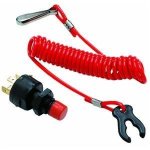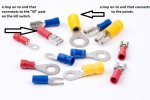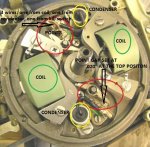Re: '61 evinrude 18hp fastwin 15034-10961 (NO SPARK IN 1 PLUG)
Hello again Daniel. The kill-switch is dead simple, if you'll pardon the pun. You simply run one wire to each set of points to the back of the switch. The point end of the wire will need a little crimp-on eye, while the switch end of the wire will need a crimp-on female adapter. You simply mount the eye to the points using the small screw that holds the coil wire and condenser wire in place. The switch end simply slips over the male post on the back of the switch itself. That's really all there is to it. The only tricky bit is routing the wires. Here are some pics of the fittings you'll need.




As far as the ignition system as a whole, it's pretty ingenious system commonly referred to as a "magneto" (that's where they got the name for the X-men character). It essentially operates off of the natural phenomenon of electromagnetic induction in which an electrical current is created by moving a magnet past coils of copper (aka "a coil"). In this case the magnet is molded into the inner rim of the flywheel. When you pull/rotate the flywheel clockwise, the magnet passes the face of the coils, so named because they are simply large coils of copper wire mounted on an iron base and encased in plastic. By definition, any time a magnet passes by a copper wire, or vise versa, an electrical current is produced. The strength of the current depends on the strength of the magnet, the amount of copper and their proximity. The more powerful the magnet, the more coils and the closer they are, the stronger the current will be. Once the magnet passes by the face of the coil, a current is created which then travels to the capacitors (little smooth round cylinders). Capacitors are short term (milliseconds) storage devices that can hold/store a charge briefly, then release it all at once in a single "zap". If you've ever worked with Leyden Jars in science class, it's the same phenomenon. These capacitors release their zap when the points are opened by the rotating cam shaft lobe. This causes an intentional shorting the system, which causes the spark plug to fire and ignite the fuel. The points themselves operate sort of like clam shells, or castanets. As one pair is closed, the other is open which creates the alternate firing of the cylinders. As you can see it's a pretty simple system that relies on a natural phenomenon, rather than an outside source, to create the spark needed to ignite the fuel. Each cylinder uses 1 coil, 1 capacitor, 1 set of points, 1 spark plug wire and 1 spark plug and that's it. Not much to go wrong really. Modern motors, on the other hand, use solid state technology to crate a spark and generally rely on voo doo and black magic, which is why most folks here try to avoid them

Hope that helps.
Here's another link that explains it too.
Magnetos























